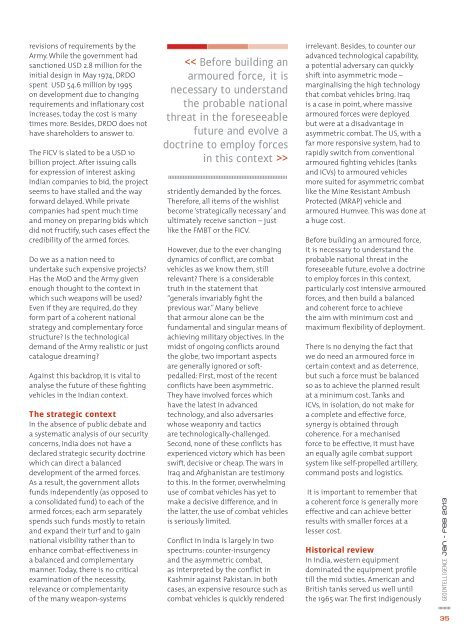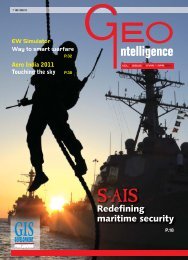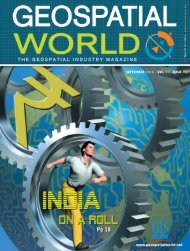Download PDF - Geospatialworld.net
Download PDF - Geospatialworld.net
Download PDF - Geospatialworld.net
Create successful ePaper yourself
Turn your PDF publications into a flip-book with our unique Google optimized e-Paper software.
evisions of requirements by theArmy. While the government hadsanctioned USD 2.8 million for theinitial design in May 1974, DRDOspent USD 54.6 million by 1995on development due to changingrequirements and inflationary costincreases, today the cost is manytimes more. Besides, DRDO does nothave shareholders to answer to.The FICV is slated to be a USD 10billion project. After issuing callsfor expression of interest askingIndian companies to bid, the projectseems to have stalled and the wayforward delayed. While privatecompanies had spent much timeand money on preparing bids whichdid not fructify, such cases effect thecredibility of the armed forces.Do we as a nation need toundertake such expensive projects?Has the MoD and the Army givenenough thought to the context inwhich such weapons will be used?Even if they are required, do theyform part of a coherent nationalstrategy and complementary forcestructure? Is the technologicaldemand of the Army realistic or justcatalogue dreaming?Against this backdrop, it is vital toanalyse the future of these fightingvehicles in the Indian context.The strategic contextIn the absence of public debate anda systematic analysis of our securityconcerns, India does not have adeclared strategic security doctrinewhich can direct a balanceddevelopment of the armed forces.As a result, the government allotsfunds independently (as opposed toa consolidated fund) to each of thearmed forces; each arm separatelyspends such funds mostly to retainand expand their turf and to gainnational visibility rather than toenhance combat-effectiveness ina balanced and complementarymanner. Today, there is no criticalexamination of the necessity,relevance or complementarityof the many weapon-systems>stridently demanded by the forces.Therefore, all items of the wishlistbecome ‘strategically necessary’ andultimately receive sanction – justlike the FMBT or the FICV.However, due to the ever changingdynamics of conflict, are combatvehicles as we know them, stillrelevant? There is a considerabletruth in the statement that“generals invariably fight theprevious war.” Many believethat armour alone can be thefundamental and singular means ofachieving military objectives. In themidst of ongoing conflicts aroundthe globe, two important aspectsare generally ignored or softpedalled:First, most of the recentconflicts have been asymmetric.They have involved forces whichhave the latest in advancedtechnology, and also adversarieswhose weaponry and tacticsare technologically-challenged.Second, none of these conflicts hasexperienced victory which has beenswift, decisive or cheap. The wars inIraq and Afghanistan are testimonyto this. In the former, overwhelminguse of combat vehicles has yet tomake a decisive difference, and inthe latter, the use of combat vehiclesis seriously limited.Conflict in India is largely in twospectrums: counter-insurgencyand the asymmetric combat,as interpreted by the conflict inKashmir against Pakistan. In bothcases, an expensive resource such ascombat vehicles is quickly renderedirrelevant. Besides, to counter ouradvanced technological capability,a potential adversary can quicklyshift into asymmetric mode –marginalising the high technologythat combat vehicles bring. Iraqis a case in point, where massivearmoured forces were deployedbut were at a disadvantage inasymmetric combat. The US, with afar more responsive system, had torapidly switch from conventionalarmoured fighting vehicles (tanksand ICVs) to armoured vehiclesmore suited for asymmetric combatlike the Mine Resistant AmbushProtected (MRAP) vehicle andarmoured Humvee. This was done ata huge cost.Before building an armoured force,it is necessary to understand theprobable national threat in theforeseeable future, evolve a doctri<strong>net</strong>o employ forces in this context,particularly cost intensive armouredforces, and then build a balancedand coherent force to achievethe aim with minimum cost andmaximum flexibility of deployment.There is no denying the fact thatwe do need an armoured force incertain context and as deterrence,but such a force must be balancedso as to achieve the planned resultat a minimum cost. Tanks andICVs, in isolation, do not make fora complete and effective force,synergy is obtained throughcoherence. For a mechanisedforce to be effective, it must havean equally agile combat supportsystem like self-propelled artillery,command posts and logistics.It is important to remember thata coherent force is generally moreeffective and can achieve betterresults with smaller forces at alesser cost.Historical reviewIn India, western equipmentdominated the equipment profiletill the mid sixties. American andBritish tanks served us well untilthe 1965 war. The first indigenouslyGEOINTELLIGENCE jan - feb 201335





